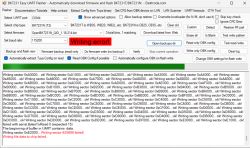Hello
I am looking for a solution that, at no great cost, will allow me to manage online the temperature in 5 rooms in my house.
I currently have a satel 128 plus integrator , a salusa it500 thermostat and a salusa it300 wireless sensor , and of course a salusa shortage to have online access. Unfortunately it500 is only able to operate 2 zones.... At my place it is the ground floor and the 1st floor. Downstairs I have underfloor heating and on each loop I already have a salusa valve controlled by 230v (this will allow me in the future to extend the system with online selection thanks to e.g. integra which loop is to be heated, I only need a couple of relays and from 1-2 hours of my work ) . I have 9 radiators upstairs and underfloor heating in the bathroom. If I had a raki manifold upstairs like I have for the underfloor heating system downstairs I would also fit actuators there for about 50 zł salus and I wouldn't have to buy electro-valves for about 150 zł for each radiator or floor circuit. I'm already thinking about replacing the manifold upstairs with the one I have downstairs for the floor. Cheaper than buying 9 solenoid valves now.
) . I have 9 radiators upstairs and underfloor heating in the bathroom. If I had a raki manifold upstairs like I have for the underfloor heating system downstairs I would also fit actuators there for about 50 zł salus and I wouldn't have to buy electro-valves for about 150 zł for each radiator or floor circuit. I'm already thinking about replacing the manifold upstairs with the one I have downstairs for the floor. Cheaper than buying 9 solenoid valves now.
Unfortunately, since the it500 only covers 2 zones, I guess I will have to sell it and look for 5 inexpensive thermostats that can be operated online in a fairly convenient way. I have a Termet Ecocondens gold plus 25.kW boiler with 10x modulation. I am in the process of checking how much the cooker burns for me per hour when heating the whole house at 60 degrees . When I have a moment I will check how much it burns at 55 degrees, how much at 50 .... how much on 54 and how much on 40:) less I don't think there is anything to set because the radiators would have to heat up half a day before they would heat up in the rooms upstairs:) Any advice welcome.... I'm green on the subject:)
Do you know of any thermostats that can be managed online and are not particularly expensive? They could give a signal to the Integra and the integra would open the solenoid valves or actuators.
I am looking for a solution that, at no great cost, will allow me to manage online the temperature in 5 rooms in my house.
I currently have a satel 128 plus integrator , a salusa it500 thermostat and a salusa it300 wireless sensor , and of course a salusa shortage to have online access. Unfortunately it500 is only able to operate 2 zones.... At my place it is the ground floor and the 1st floor. Downstairs I have underfloor heating and on each loop I already have a salusa valve controlled by 230v (this will allow me in the future to extend the system with online selection thanks to e.g. integra which loop is to be heated, I only need a couple of relays and from 1-2 hours of my work
Unfortunately, since the it500 only covers 2 zones, I guess I will have to sell it and look for 5 inexpensive thermostats that can be operated online in a fairly convenient way. I have a Termet Ecocondens gold plus 25.kW boiler with 10x modulation. I am in the process of checking how much the cooker burns for me per hour when heating the whole house at 60 degrees . When I have a moment I will check how much it burns at 55 degrees, how much at 50 .... how much on 54 and how much on 40:) less I don't think there is anything to set because the radiators would have to heat up half a day before they would heat up in the rooms upstairs:) Any advice welcome.... I'm green on the subject:)
Do you know of any thermostats that can be managed online and are not particularly expensive? They could give a signal to the Integra and the integra would open the solenoid valves or actuators.






